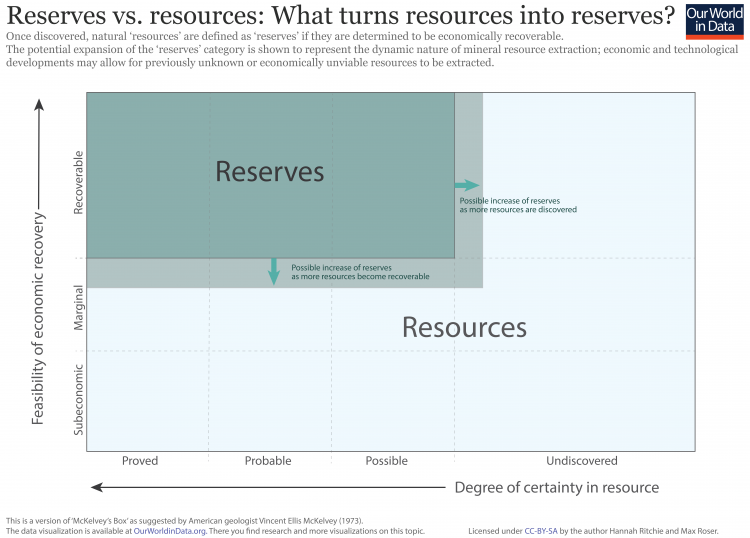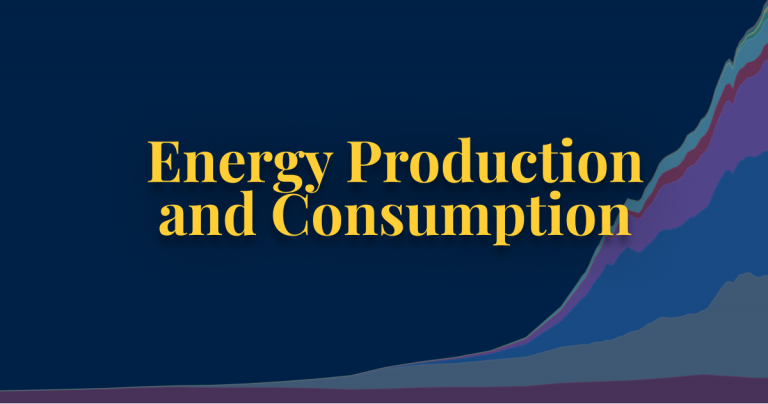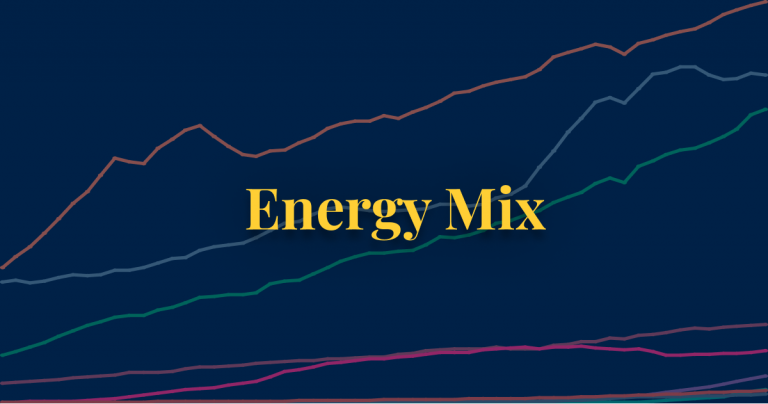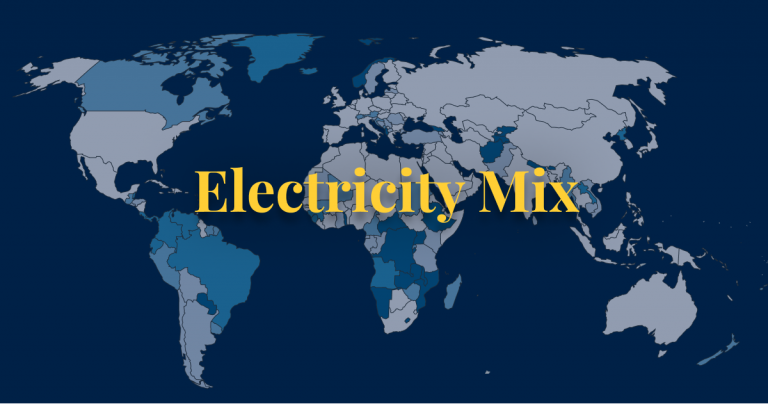For most of human history our ancestors relied on very basic forms of energy: human muscle, animal muscle and the burning of biomass such as wood or crops. But the Industrial Revolution unlocked a whole new energy resource: fossil fuels. Fossil energy has been a fundamental driver of the technological, social, economic and development progress which has followed.
Fossil fuels (coal, oil, gas) have, and continue to, play a dominant role in global energy systems.
But they also come with several negative impacts. When burned they produce carbon dioxide (CO2) and are the largest driver of global climate change. They are also a major contributor to local air pollution, which is estimated to linked to millions of premature deaths each year.
As low-carbon sources of energy – nuclear and renewables – become readily available, the world needs to rapidly transition away from fossil fuels.
This article presents the long-run and recent perspectives on coal, oil and gas – how much countries produce and consume; where our fossil fuel reserves are; and what role the fuels play in our energy and electricity systems.
Interactive charts on Fossil Fuels
Global fossil fuel consumption
The burning of fossil fuels for energy began around the onset of the Industrial Revolution. But fossil fuel consumption has changed significantly over the past few centuries – both in terms of what and how much we burn.
In the interactive chart we see global fossil fuel consumption broken down by coal, oil and gas since 1800. Earlier data, pre-1965, is sourced from Vaclav Smil’s work on energy transitions; this has been combined with data published in BP’s Statistical Review of World Energy from 1965 onwards.1
Fossil fuel consumption has increased significantly over the past half-century, around eight-fold since 1950, and roughly doubling since 1980.
But the types of fuel we rely on has also shifted, from solely coal towards a combination with oil, and then gas. Today, coal consumption is falling in many parts of the world. But oil and gas are still growing quickly.
Fossil fuel consumption: which countries use the most energy from fossil fuels?
We’ve looked at how much fossil fuel energy is consumed globally. But what about countries? How much fossil energy do they consume?
The interactive chart here shows the amount of primary energy from fossil fuels that is consumed each year.
This is the sum of energy from coal, oil and gas. In the sections below we look at each of these sources individually.
Three tips on how to interact with this map
- By clicking on any country on the map you see the change over time in this country.
- By moving the time slider (below the map) you can see how the global situation has changed over time.
- You can focus on a particular world region using the dropdown menu to the top-right of the map.
Per capita: where do people consume the most energy from fossil fuels?
Related chart:
Looking at energy consumption at the country level is often a strong reflection of population size rather than actual fossil fuel consumption per person.
How do these comparisons look when we adjust for population?
In the interactive chart we see the amount of energy from fossil fuels consumed per person. This is the sum of primary energy from coal, oil and gas combined.
Across the world we see that the largest consumers use more than ten times the amount of fossil energy than some of the smallest consumers.
Four tips on how you can interact with this chart
- Change the bar chart into a line chart: by clicking on the timeline at the bottom of the chart you can change the bar chart into a line chart.
- See the change over time: Using the ‘play’ button on the timeline you can see how this metric changes over time.
- Add any other country: click on the Add country button to compare with any other country.
- See the data on a world map: click on the ‘MAP’ tab to see the global overview across countries.
Fossil fuel consumption by type
In the sections above we looked at the consumption of fossil fuels collectively. But it’s important to look at the role of coal, oil and gas individually – their impacts are not equal. Coal, for example, typically produces more CO2 and local air pollution per unit of energy [see our article on the relative safety and impacts of different energy sources].
In the interactive charts here we fossil fuel consumption disaggregated by type. This is shown as a stacked area chart – useful for seeing the relative contribution of each; but also as a line chart which allows us to see how the consumption of each is changing over time.
How you can interact with the stacked area chart
- In these charts it is always possible to switch to any other country in the world by choosing Change Country in the bottom left corner.
- By unticking the ‘Relative’ box, you can switch to see the breakdown of emissions in absolute terms.
What share of primary energy comes from fossil fuels?
How do fossil fuels fit in within the rest of the energy mix? What share of primary energy comes from fossil fuels?
In 2019, around 84% of global primary energy came from coal, oil and gas. Over the coming decades we need to rapidly reduce this share by displacing them with low-carbon energy sources.
In the interactive chart we see how this share varies across the world.
A few points to keep in mind when considering this data:
- These figures reflect energy consumption – that is the sum of all energy uses including electricity, transport and heating. Many people assume energy and electricity to mean the same, but electricity is just one component of total energy consumption. We look at electricity consumption later in this profile.
- These figures are based on primary energy consumption – given by the ‘substitution method’. You can read our explainer on the different metrics used to measure energy here.
Two tips on how you can interact with this chart
- View the data for any country as a line chart: click on any country to see its change over time, or by using the ‘CHART’ tab at the bottom.
- Add any other country to the line chart: click on the Add country button to compare with any other country.
What share of electricity comes from fossil fuels?
Electricity is one component of total energy consumption – the other two being transport and heating.
Globally, fossil fuels account for a much smaller share of electricity production than the energy system as a whole. In 2019, around 64% of our electricity came from fossil fuels.
This interactive map shows the share of electricity that comes from fossil fuels (coal, oil and gas summed together) across the world. Oil accounts for only a small share of electricity production – most come from coal and gas. The share from coal and gas individually can be found in the sections below.
Coal production: how much do countries produce?
Which countries produce the most coal? How has this changed over time?
In the interactive chart here we see coal production by country. This has been converted into primary energy equivalents (i.e. terawatt-hours of energy) for comparability across our other data on energy.
Note that this measures coal production, not consumption. Many countries consume energy from coal in their energy supply. But not all countries have coal reserves to produce this themselves. This therefore measures coal production before trade between countries.
Energy from coal: how much do countries consume?
Related charts:
Fossil fuel production is an important metric to follow – it helps us understand where fossil fuels are being extracted. But we also care about where that energy is being consumed – that tells us what role fossil fuels are playing in the energy system of each country.
This interactive chart shows primary energy consumption from coal across the world. This represents coal production adjusted for trade (so, coal exports are subtracted and imports are added).
What share of primary energy comes from coal?
Coal has been a critical energy sources, and mainstay in global energy production for centuries.
But it’s also the most polluting energy source: both in terms of the amount of CO2 it produces per unit of energy, but also the amount of local air pollution it creates. Moving away from coal energy is important for climate change as well as human health.
This interactive map shows the share of primary energy that comes from coal across the world.
What share of electricity comes from coal?
Coal is currently the largest source of electricity globally. For many countries remains the dominant source. But, we also see that others have seen a massive shift away from coal in recent years – the UK is one such example.
This interactive map shows the share of electricity that comes from coal across the world.
When do countries plan to phase out coal?
Coal is the world’s oldest industrial source of energy. It is still a dominant source of energy across the world today – especially within our electricity mix.
But coal is the world’s dirtiest fuel – it not only emits the most carbon dioxide emissions per unit of energy, it has severe impacts on health through air pollution.
Many countries are therefore committing to phasing coal power out of their electricity mix. This map shows country pledges to achieve this. Some countries are already coal-free. Some have set to phase it out by 2030; 2040 or later. Some have not yet committed to eliminating it.2
Oil production: how much do countries produce?
Which countries produce the most oil? How has this changed over time?
In the interactive chart here we see oil production by country. This has been converted into primary energy equivalents (i.e. terawatt-hours of energy) for comparability across our other data on energy.
Note that this measures oil production, not consumption. Many countries consume energy from oil in their energy supply. But not all countries have oil reserves to produce this themselves. This therefore measures oil production before trade between countries.
Energy from oil: how much do countries consume?
Related charts:
Oil production is an important indicator to follow – it helps us understand where it’s being extracted, who the main oil producers are, and how this related to oil reserves. But we also care about where that oil is being consumed – that tells us what role it’s playing in the energy system of each country.
This interactive chart shows primary energy consumption from oil across the world. This represents oil production adjusted for trade (so, oil exports are subtracted and imports are added).
What share of primary energy comes from oil?
Oil is the world’s largest energy source today. It is the dominant source of energy for the transport sector in particular.
This interactive map shows the share of primary energy that comes from oil across the world.
Gas production: how much do countries produce?
Which countries produce the most gas? How has this changed over time?
In the interactive chart here we see gas production by country. This has been converted into primary energy equivalents (i.e. terawatt-hours of energy) for comparability across our other data on energy.
Note that this measures gas production, not consumption. Many countries consume energy from gas in their energy supply. But not all countries have gas reserves to produce this themselves. This therefore measures gas production before trade between countries.
Energy from gas: how much do countries consume?
Related charts:
In the section above we looked at where in the world gas is produced. But, after trade, where in the world is gas consumed?
This interactive chart shows primary energy consumption from gas across the world. This represents gas production adjusted for trade (so, gas exports are subtracted and imports are added).
What share of primary energy comes from gas?
Natural gas has, for decades, lagged behind coal and oil as an energy source. But today its consumption is growing rapidly – often as a replacement for coal in the energy mix. Gas is a major provider of electricity production, and a key source of heat.
This interactive map shows the share of primary energy that comes from gas across the world.
What share of electricity comes from gas?
Gas is now the second largest source of electricity production globally.
Its contribution is growing quickly in many countries as they substitute it for coal in the electricity mix. From a climate perspective, this transition is positive since gas typically emits less CO2 per unit of energy. But, we still ultimately want to shift away from gas towards low-carbon sources such as renewables and nuclear.
Gas is now the second largest source of electricity production globally.
Its contribution is growing quickly in many countries as they substitute it for coal in the electricity mix. From a climate perspective, this transition is positive since gas typically emits less CO2 per unit of energy. But, we still ultimately want to shift away from gas towards low-carbon sources such as renewables and nuclear.
This interactive map shows the share of electricity that comes from gas across the world.
This interactive map shows the share of electricity that comes from gas across the world.
Coal reserves
In previous sections we looked at how much fossil fuels different countries produced or consumed. But where in the world does our existing reserves of fossil fuels remain?
Which countries have the potential to extract and sell them?
In the interactive chart we see proved coal reserves across the world.
It’s important to distinguish reserves versus resources here. “Proved reserves” represents coal that we know with reasonable certainty could be recovered in the future under existing economic and technological operating conditions. In other words, we know it’s there and it would be technologically and economically feasibly to extract it.
Reserves represent only some fraction of resources, however; we continue to discover new quantities of coal, and with time more becomes technologically feasible to extract. This means our quantity of reserves changes all the time – not only based on how much we consume, but by how much new resources are ‘unlocked’.
We look at the difference between reserves and resources in more detail here.
Gas reserves
Where in the world do we have gas reserves? Which countries have the ability to extract, consume and trade?
In the interactive chart we see proved gas reserves across the world.
It’s important to distinguish reserves versus resources here. “Proved reserves” represents coal that we know with reasonable certainty could be recovered in the future under existing economic and technological operating conditions. In other words, we know it’s there and it would be technologically and economically feasibly to extract it.
Reserves represent only some fraction of resources, however; we continue to discover new quantities of gas, and with time more becomes technologically feasible to extract. This means our quantity of reserves changes all the time – not only based on how much we consume, but by how much new resources are ‘unlocked’.
We look at the difference between reserves and resources in more detail here.
Three-quarters of global greenhouse gas emissions come from energy production. To stand a chance of meeting our climate change targets, we must rapidly reduce CO2 emissions from fossil fuels.
Explore our related work on CO2 emissions – where they come from and how they are changing over time.
The terms ‘reserves’ and ‘resources’ are often used interchangeably. However, there is an important distinction between the two. The chart explains this distinction visually.
It is true that every reserve is a resource, but not every resource is a reserve. There are two requirements which determine whether a mineral resource becomes a reserve. The first is the degree of certainty that it exists: the planet likely has many mineral resources which we have not yet discovered. So to be defined as a reserve, we must have either a proved, probable or possible understanding of its existence. The second criteria relates to the economic feasibility of being able to access and extract the mineral resource. To be defined as a reserve, it must be economically and technologically viable to recover. If the economics are subeconomic (i.e. would result in a net loss) or marginal, a mineral resource is not defined as a reserve.
Whilst the original source of this concept – the American geologist Vincent McKelvey – visualised it as a static box, this transition between resources and reserve classifications is dynamic. As we discover previously unknown resources, and develop improved extraction technologies for economic recovery, this reserves box can grow with time (or shrink as we consume them).

To maintain consistency between metrics and sources, we have attempted to normalise all energy data to units of watt-hours (Wh), or one of its SI prefixes. The table shows the conversion of watt-hours to the range of SI prefixes used.
| SI Unit | Watt-hour (Wh) equivalent |
| Watt-hour (Wh) | – |
| Kilowatt-hour (kWh) | One thousand watt-hours (103 Wh) |
| Megawatt-hour (MWh) | One million watt-hours (106 Wh) |
| Gigawatt-hour (GWh) | One billion watt-hours (109 Wh) |
| Terawatt-hour (TWh) | One trillion watt-hours (1012 Wh) |
- Data: BP publishes data on Oil, Gas Coal, Nuclear Energy, Hydroelectricity, Renewables, Primary Energy Consumption, Electricity Generation, Carbon Doixide Emissions
- Geographical coverage: Global – by country and region
- Time span: Annual data since 1951
- Available at: Online at www.BP.com
- Data: Historical Energy Consumption Statistics and Historical Energy Production Statistics
- Geographical coverage: Global – by country and world region
- Time span: Since 1900
- Available at: Both datasets are online at www.tsp-data-portal.org.
- Data: Data on electricity, oil, gas, coal and renewables. Data on CO2 emissions (also projections)
- Geographical coverage: Global – by country
- Time span: Last decades
- Available at: Online at www.iea.org
- The IEA is publishing the World Energy Outlook.
- You have to pay to access the IEA databases. But some data is available through Gapminder, for example Residential Energy Use (%). (for few countries since 1960, for more countries since 1971 or 1981)
- Data: Total and crude oil production, oil consumption, natural gas production and consumption, coal production and consumption, electricity generation and consumption, primary energy, energy intensity, CO2 emissions and imports and exports for all fuels
- Geographical coverage: Global – by country
- Time span: Annual data since 1980
- Available at: Online at ww.eia.gov
- EIA is a US government agency.
- Geographical coverage: Global – by country and world region
- Time span: Last decades
- Data: Energy use (kt of oil equivalent) – Energy use (kg of oil equivalent per capita) – Energy production (kt of oil equivalent)
- Many more related indicators.
- Data: Production & consumption of energy.
- Geographical coverage: Europe
- Time span:
- Data on: Energy production and imports – Consumption of energy – Electricity production, consumption and markets.












